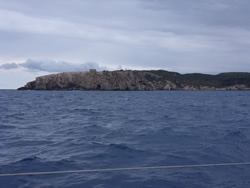
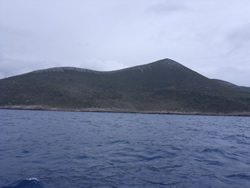
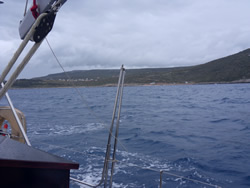
|
Any comments or questions please contact us: kevin@sailawayonline.co.uk or ann@sailawayonline.co.uk (Please note our reply depends on available internet access, we will reply to you as soon as possible.) |
Greece - The Southern Ionian
To view our previous log entries please use the following link:
Greece - The Northern Ionian II (2011).
To view our next log entries please use the following link:
Log Entry Wednesday 20th April - We leave Pilos and continue south to Crete.
At last it looks like we may have a window to leave, I had checked the weather about earlier about 0730 hours and it had looked pretty grim - bad enough not to travel? As we sat in the cockpit after breakfast drinking coffee, we watched as two couples from two boats down the quay walked rapidly into town and returned with supplies, the boats then started up and left abruptly, had some thing changed? It was now almost 1000 hours, I went on line and checked the weather again, it had indeed changed quite significantly from earlier? I down loaded two weather sources and to my amazement they both agreed, which in itself was unusual. I knew that one French boat had defiantly turned south but to where to I did not know. We discussed the idea of moving, the next leg was to be a significant jump of 175 miles south to Rethymno on Crete. There was no real safe harbours in between Pilos and Crete should they be needed due to bad weather or other problems, so the decision to leave at the right time was an important one to us. We agreed that we would recheck the weather after the next update due later that day, if it declared the same, (as weather forecasts change by the minute at this time of year) then we would go. As it stood at the moment the weather was providing a safe window of 48 hours to complete the trip - it would take us about 36 hours? We were so confident we went into town to pick up a few supplies, mainly fruit, vegetables and yogurts. Ann always makes soup for the over night passages as it is remarkable how cold it still is - home made soup and fresh bread warms you through. After the shopping we wished our farewells in advance to the friends we had made in Pilos, that took some time in itself.
Back at last on Sailaway we down loaded the latest weather and yes, the 48 hour window was still there, this time checked from three sources - we were by now ready to leave, only the final goodbyes to our neighbour and then to loosen off our lines. Within twenty minutes, around 1700 hours we were leaving the marina, the timing was good as it meant we would be arriving at Rethymno in the hours of day light.
 |
 |
 |
Out in the ormos had quite a stiff northerly breeze, we had no longer left the marina and our main sail was up, the first time for almost four weeks, we sailed hard into the swell over the bar of the ormos, the swell quite large considering the gales had dropped some time earlier? With all of our canvas up sailaway took the swell in her stride as she always did, we were making good speed (7/8 knots) south down the west coast of the Peleponnese.
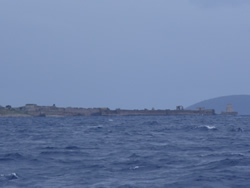 |
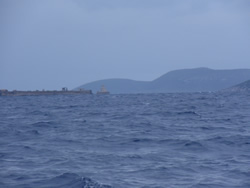 |
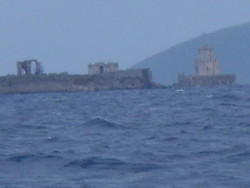 |
Within no time we were passing the magnificant castle structure at Methoni of which we had visited by coach, the dull, dreary skies spoiling the view effectively, but still just as impressive however, a monument of it's time.
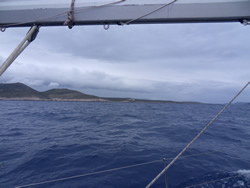 |
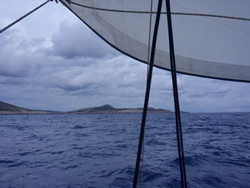 |
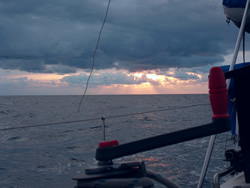 |
After Methoni we passed the island of Longos, we decided to head well south, before turning east to try and maximise on the northerly winds, as passing too close to the islands would shelter us from the wind. We did so and the wind stayed with us, at least for a while but as we passed the island of Skhiza the wind began to swing to the east, we adjusted coarse to keep us sailing but before long the wind dropped to almost zero and appeared on the nose no matter watch coarse we took - we had no option than to start the engine. As darkness fell we had a companion on board, a small "swift type" bird had circled us a few times. With the activity of Ann and I, accompanied with the engine noise the bird still joined us, perching in the corner of the cockpit flour, probably enjoying the heat from the engine radiating up? We gave the bird bread but it seemed uninterested, we now had to be very careful with out feet as not to trample on it? We motored through the night, the engine providing a great source of heat to keep us and our small friend warm. The traffic during the night was significant, the busiest we had ever experienced, all eyes open of coarse. At one time, as we headed southeast I counted ten vessels in front and six behind. We were over taken at one point by two freighters to the north of us and a brightly lit cruise cruise ship to the south, both tracking approximately 1000 meters either side of us, it was quite an unsettling time until their coarse became clear?
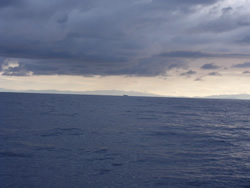 |
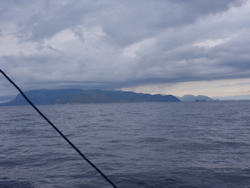 |
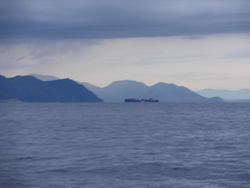 |
We saw day break with again full grey skies, our new friend had not moved all night, it was hard to see if he had eaten or not? Ahead of us was the island of Kithera, in the distance Anti Kithera. The sea had now flattened off completely, there was no wind to build it, "all calm" as we say. We were on schedule, our near location to land allowed us to down load the weather, nothing had changed, great news as we had very few options other than to carry on. We were to take a short cut through the "Stenos Kitheron" a channel between the islands only negotiable by small vessels such as Sailaway in the best of weather conditions. Ann was down below preparing breakfast, in the cockpit I had noticed earlier a slight increase in engine temperature, I had for some time been focused on the gauge. Ann called to me "Kevin, I think the engine smells hot?" At the same time I saw the temperature gauge rise significantly, very quickly, I slowed it down and switched it off. We we in open water some ten miles west of Kithera, our coarse had taken us well clear of the traffic, therefore no issues there. We now had to get down below to see what the issue was, it was not too difficult to see a coolant hose leaking. It had failed after years of faithful service, a combination of age and vibration? It was, by good management if I say so my self that we had a meter section of the hose within our spares stock, but we had to allow the engine to cool down to make it easier to work on. Once cool enough the hose was replaced and the coolant topped up, more problems, the boot on the exhaust side of the heat exchanger and split and coolant was escaping as fast as I could put it in? One can only assume that due to the close proximity of the hose to the boot it had been damaged during the hose replacement? At this point who cares, and yes we had a spare, on it went and we then ran the engine up to temperature with out any issues. We continued on, monitoring the engine gauges as we wanted to be sure that all was good before we entered the channel, and it was.
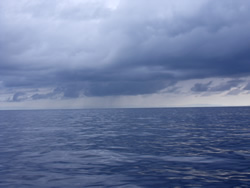 |
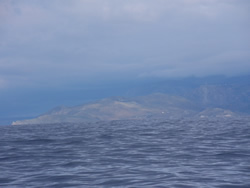 |
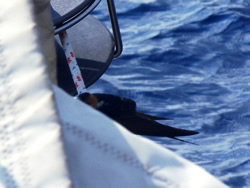 |
Making our way on the skies did not clear at all, this weather obviously with us today again? Our little friend was now awake with all the activity, we thought he was sick perhaps, he shook him self and flew off, he circled a few times then landed on the headsail furling halyard (rope), perched for a while then flew off never to be seen again, hopefully safe?
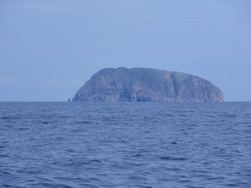 |
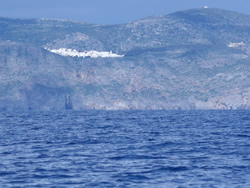 |
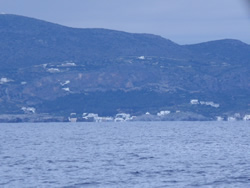 |
We made through the channel to the south of Kithera, just south of "Vrak Avgo", "Kapsali", the main town on the island became visible, it offered good protection against the pending northerlies, but non against any southerlies, we did not want to risk a visit at this time of year hence the reason to carry on.
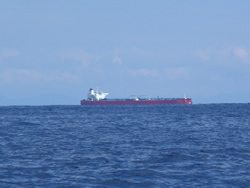 |
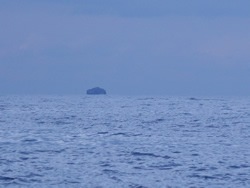 |
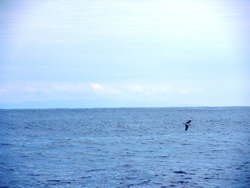 |
The traffic had now changed, around these islands only large petrochemical tankers skirted the island east to west and vice versa, freighters never seen? The channel is notorious for bad seas, the depths vary from 50 to 1000 meters which effect/create wave changes, there are also so many rock out crops and small islands all creating confused seas. As we came over a 50 meter shelf, the previous half meter swell grew enormously to well over two meters, picking us up high, taking us forward, then dropping us down as carefully as the sea had picked us up. A great experience but it also gave some magnitude to the effect of bad weather in this area. Once through the islands we saw only one ship for the rest of the journey to Crete, we had only the sea birds to keep us company. We had gone from hectic traffic to nothing at all in a very short distance, darkness began to fall, another cold evening with no external activity what so ever to occupy our minds - a long night ahead.
To continue our journey to Crete please use the following link:
(And continue with Log Entry Wednesday 20th April)
Log Entry Wednesday 13th April - Methoni by coach.
Methoni, around the southern peninsular was to be our next port of call with Sailaway, however it offers little protection against the unpredictable strong winds we are experiencing. At this time of year the weather has a mind of it's own, and the forecasts carry little accuracy. With all that in mind we have now changed our plans, when the current winds ahead of us drop off we will jump straight to Crete a mere thirty hours or so away. There will then be no possibility of us being pinned down again due to weather on the northern side of the Kithera Sea where the weather is more volatile. With all that in mind we decide to take the coach to Methoni to have a look around the castle we have heard so much about.
 |
 |
 |
The trip is relatively short, only 11km, the town is a very modern one, tourism appearing to be it's only source of revenue? The centre and around the beach recently modernised, now lined with hotels and apartments. The good thing for us is that it is still early in the season, few tourist around with lots of preparation ongoing for their arrival.
 |
 |
 |
The town is very quite, very well kept and clean, the two main streets running parallel down to the water front.
 |
 |
 |
Even the beach is being cleaned up, all of the winter storm debris being removed by a mechanical digger. There is an excellant taverna on the beach set against the castle walls and small break water, but it too is still closed.
 |
 |
 |
The main streets join the beach, which is also equipped with a children's play area, shaded by trees. The small square is, as one would expect, dominated by a number of tavernas, only fifty percent of them open, a couple of relatively new, modern hotels over look the square and beach.
Methoni is mentioned by ancient historians in relation to events
regarding Messenian (8th BC) and the Peloponnesian Wars (5th BC). During the
Roman times the city gains it autonomy, however the archaeological remains of
this period are rather scarce.The existence of the city during Byzantine times
is proven both by surviving monuments and many historic sources. From 1205 to
1500 Methoni is under Venetian rule and becomes one of the most crucial commercial
centres of the eastern Mediterranean. Numerous travelers and pilgrims stopped
here on their way to the Holy Land. During 1500 the Turks conquer the castle,
the population is then slaughtered and new inhabitants were installed from other
areas of the Peleponnese. During the Greek Revolution (1821) the castle serves
as a refuge for the Muslim population of the area and in 1828 it became a Turkish-Egyptian
garrison HQ. In 1828 Methoni is taken by the French (Gen. Masion), most of the
buildings within the walls were destroyed and have remained that way since,
the original layout, streets and building can clearly be seen in places.
 |
 |
 |
It is a short walk along the beach to the castle, "The walls of Methoni", only a few small sections of the wall remain from the Byzantine times. The earliest current construction dates back to the first Venetian rule (13 - 15th century). During this period Methoni was a seaside strong hold, during the 15th century the castle began a series of modifications and updates to move with the times and be able to with stand artillery fire. Low, octagonal constructions named "bastions" were built out side the medieval precinct and the width of the walls was significantly increase to resist the impact of cannon balls. The central gate remains impressive even today, decorated with Corinthian style pillars with spear and banners. The structure was built around 1714 during the second Venetian rule. Until 1828 the bridge was wooden, supported by stone pillars. The modern construction and it's 14 pillars was built by the French expeditionary forces under General Masion (1828-30).
The moat separates the castle from the mainland and the north wall towers high above it. The original moat construction dates back to the 13th century. The moat was unsuccessfully modified by the Venetians to try and bring the sea into the moat.
 |
 |
 |
 |
 |
 |
The great "Square of Arms" was a reference point for the social life
of the Venetian and Ottoman era. Through the many contemporary travelers accounts
and historic documents a vivid picture of the former cities wooden houses and
narrow paved streets. The granite column, 3'7 meters in height came from an
early ship wreck around nearby Cape Spitha, dating back from the Venetian times
it has an inscription dated 1493. A "Lion of St Marcus" stands nearby
depicting a coat of arms, that of governor Pietro da Canal. The slab placed
high on top
of the column contain a further three coats of arms of the governors associated
with Methoni circa. (1300 - 1400 A.D.)
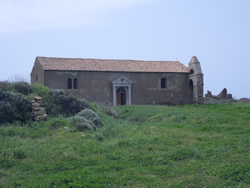 |
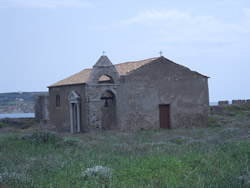 |
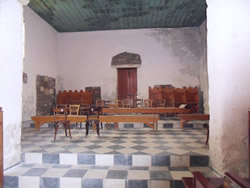 |
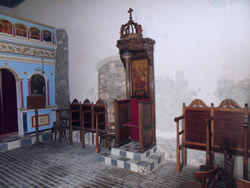 |
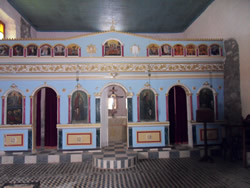 |
No construction would be complete without a church, situated off the "Square of Arms", it is in remarkable condition, seats arranged as such it would appear still in use?
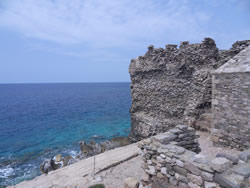 |
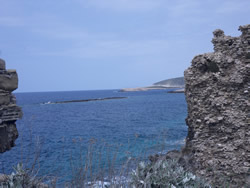 |
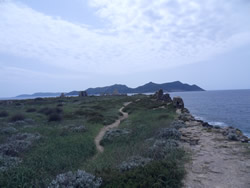 |
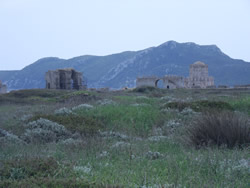 |
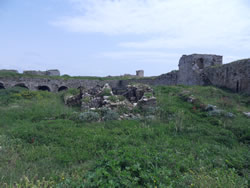 |
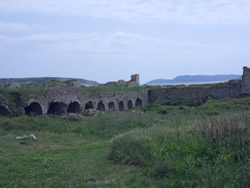 |
The structure is as impressive as the stories we were told, it's history some what bloody at times, it is well worth a visit if one is around.
Log Entry Saturday 9th April - Play time for all.
Today I (Kevin) have scheduled two dives with the local dive school, I am to be picked up by the dive boat from Sailaway at 1100 hours. Like any small child waiting for his treat the morning passes very slowly, due to the now ever increasing heat from the sun, I will not put on my wet suit until the last moment, the water however is only 16C.
 |
 |
 |
While Ann and I wait on deck with a coffee we hear the sound of a high revving engine from the boat yard across the water. At first we thought it was some one with an out board engine then our attention is drawn to a parachute in amongst the boats on the hard standing - it is a motorised para glider? He turns into the wind, filling his chute, increases engine speed and off he goes. He sores high above us but never really cuts his engine the breeze is very light, his flight only lasts about ten minutes or less before he lands again on the hard standing - too little wind perhaps?
 |
It looks at first as if he is coming in too fast but the engine is then put hard into reverse and he hits the ground running. He is met by a female, within minutes he is packed away into a camper van and off they drives. The trip, though short looks fun - must try that next!
 |
 |
 |
The dive boat arrives and I climb on board with all my gear, it is amazing the amount of gear one has to carry. My weight belt alone, used to control my buoyancy, enabling me to sink is 10kg (22lb). This is partially due to my semi dry wet suit so I should be able to reduce it as it gets warmer and I stop wearing my suit. We "scream", as dive boat do, over to the islands at the opening of the great ormos and drop anchor. We under go a safety briefing and are paired up, each responsible for the other, then comes the important bit - in the water we go! We carry out two dives, using two ten litre tanks of air at different locations around the inner, sheltered shores of the rocky islands. It is clear from the swell and the turbulence in the water that the sea is still quite rough out side in the open water. This is visually confirmed as we later watch the "long line fishing boats" enter the swell as they leave on their search for sword fish and the such like. The dive was interesting, down to about 16 meters maximum depth, one searches the sea bed and rocky, under water cliffs for any thing of interest? We see octopuses, one almost a meter across, starfish and large grouper, I do need to under stand better what I see, I do not know much about the species of sea life, especially the smaller, more colourful creatures? At one section of rock outcrops we find an old fisherman style sea anchor about one and a half meters high, discarded by some unfortunate person? With our dives over we again race back to the port, I have secured a lovely coloured shell for Ann's collection, highly coloured, the creature once within could not have been dead long. It has been another great experience for me, looking forward to my next dive!
Log Entry Thursday 7th April - Plenty of gales ahead and company in Pilos.
There are gales to the east of us, ahead is a very volatile patch of sea between the Peleponnese and Crete, especially this time of year? In a harbour in which we have seen little traffic we are suddenly bombarded with delivery crew and vessels. About twelve in total land, six for Sunsail, there is little room for them, even we have a new neighbour for a couple of nights.
 |
 |
 |
We spend a lot of time talking to a few of the skippers and their crew, people of all nationalities, all with different tales of where they have been. They are interested in our life style also, many have the same dreams. I get Ann a trip around the floating hotel next to us - "no character, lots of white plastic and false wood - I prefer our Sailaway" was her exact words? A couple in particular very knowledgeable about the water ahead of us, two boats tied up together to find they had met before in Argentina? They all leave together, within a hour or so, the weather reports tell them the gales are weakening - must be exciting to travel in those conditions, but we prefer the calmer waters?
Log Entry Wednesday 6th April - Health and Safety in Greece, totally different and still no one killed?
We remain at Pilos, for a number of reasons, firstly we like it hear the people are great, secondly I am able to get a number of free dives in with Niko the instructor - great experience? There is a third reason we are awaiting the delivery of some new dive equipment, the failure of one unit we use caused damage to my ears. This made us re-think exactly what I wanted to do with regards diving, we decided that I would like to pursue it further than "keeping our hull clean" so new, replacement equipment is essential we feel?
We head in to town by bicycle, pick up some fruit and salad, and decide to sit in the town square and watch the world go by with a cold beer to cool us down. We are in luck, there is plenty of activity in the square, one of the trees is being "tidied up?"
 |
 |
 |
The work had already begun, the cafe tables and chairs removed from under the tree to allow access and possible damage to the furniture? Quite a crowd had already began to gather under the tree, most appearing to have quite an input to the work schedule, most pointing, waving or shouting - we sat quietly and observed? The guy and his chainsaw are lifted high into the tree in the bucket of the JCB, work is now well under way. The tree is along side the road around the square, the road is not closed and the traffic work around the JCB and falling stumps, just like in the UK?
 |
 |
No sooner do the branches hit the ground then they are scooped up and loaded into the back of a truck. Some of the larger trunks are suspended by wires, once the branch is reduced in size, the wires are cut by a second man in the bucket and they too fall to the ground. They are then cut up and loaded into the trucks too.
 |
 |
Once the bulk of the work is complete, the cafe owner further instructs how he wants the tree to be pruned. The tree is clearly illuminated in the evening, the lamps have not been removed for some reason, some do not survive and are thrown to one side? A "local" helps with the main power cables, pulling them clear as the pruning is finalised.
The key point is that the exercise was carried out at fraction of the cost it would have been in the UK, with minimal disruption to traffic - and no one died? We finished our beers, paid and returned to Sailaway for dinner.
Log Entry Wednesday 30th March - A visit to nearby Pilos Castle.
Pilos is said to have emerged as an important settlement from the prehistoric times. It's location combines fertile land with what is said to be one of the best natural harbours of the southwest Peleponnese, the Gulf of Navarinou.
 |
 |
 |
The original position of the medieval castle (Old Navarinou) overlooks Gulfs north entrance along with the ottoman fortress (Niokastro) to the south remain testimonies of the past.
 |
 |
 |
The castle, in various stages of it's development was inhabited from the 6th Century BC. Knowledge beyond that time is quite limited (4th -12th A.D. The Ottoman conquest in the 15th century continued until the Greek War of Independence (1821) with two short interruptions, the Venetians (1685) and the Russians ( 1770).
 |
 |
 |
 |
 |
 |
Following the settlement of the French in the fort following the Battle of Navarinou
and the with draw of the Turkish/Egyptian forces the fortress lay in ruins.
The French developed the town out side of the great walls. During the second
World war, Italian and german forces used Niokastro as their base. In the post
war period the fortress remained and place of recreation and a source of ready
made building materials.
 |
 |
 |
 |
 |
 |
Log Entry Tuesday 29th March - Kevin certified, to scuba dive that is!
Kevin has been keen on scuba diving for some time, having begged, borrowed, but not stolen what was needed we then met Nico who runs the local PADI training school and chandlery. Kevin was lucky to have "one to one" training, a little early in the season one presumes. With his classroom theory now over it is time for two days of diving from a nearby beach as Nico's rib is not yet in the water for the season. A little more physical effort needed to get to the deeper depths required for the various exercises.
 |
 |
Kevin loves the day, an additional dive is under taken, just for the experience and see the various sea creatures, Kevin is very excited as he explains how he carefully handled a starfish on it's way from the deep waters to shallower depths.
 |
We call into Nico's shop in the morning for the "official ceremony" - he now has his ticket, and lots of stiff muscles to accompany it!
Log Entry Monday 28th March - A local fishing boat returns after days out at sea.
A local boat returns into the maria and ties up onto the wall in front of us. We have seen this fishing boat before, they spend a couple of days in port then disappear for 2/3 days. As soon as they return, they are met as they are today by a truck and their catch removed without delay.
 |
 |
 |
We watch as the some what large fish are unloaded one by one. The truck brings a set of weighting scales which are place upon the quay, the fish are weighed, a ticket completed and stapled to the fish.
 |
 |
 |
It is some what strange to see a relatively small catch to sustain the vessel and a crew of three but when considering the price of fish in the shops and restruant's, many people do simply just not eat it due to the cost? A disturbing thought to think that the fish are becoming so scarce restruant's can charge easily €55/€60 per kilo and more for certain breeds? Unfortunately the price of the meal depends on the size of the fish cooked?
Log Entry Saturday 26th March - Independence Day, released from the Turks!
Today is a national holiday to celebrate the liberation of the Greek people from Turkish rule.
 |
 |
 |
 |
 |
 |
We watch as the small town becomes congested, full of people, there is not one seat available in the square? The school children march through the square, around the harbour to the Town Hall.
 |
 |
 |
The Town Hall is clearly prepared for speeches and celebration, the children march and congregate outside the building. The ceremony is first blessed by a priest. All is in Greek obviously so Ann and I make our way over to the square to try and get refreshments - all the seats are still full. It is explained to us that following the speeches, the school children will dance in the square, all of traditional style.
 |
 |
 |
 |
 |
 |
We meet a friend we have made, Nico and his small son, we eventually find an available table. It is explained to us that in schools in Greece, traditional dance is compulsory through out the syllabus, better dancers being sent to special colleges. It is clear that heritage is still valuable to the Greek people. It is a shame that we do not have such a thing any more?
 |
 |
The influence of such heritage is evident all around, as many, non participating children of all ages can be seen dancing along to the music?
Log Entry Wednesday 23rd March - Pilos, we love it already!
 |
Sailaway now nicely secure on the harbour wall, the water so clear?
 |
 |
 |
Outside in the bay, the great Battle of Navarinon took place on 6th July 1827, the Treaty of London between Great Britain, France and Russia provided that Greece should be autonomous but under the control of the Turks, the Greeks agreed, but the Turks did not. Codrington, the Admiral of the British fleet decided to enter the bay along with 26 allied ships with 1270 guns. The Turk/Egyptian fleet numbered 89 vessels with 2450 guns, anchored in a three quarter circle facing the entrance, in theory a perfect trap for those daring to enter the bay? An Egyptian vessel inadvertently fired a shot and the battle began, continuing for 4 hours, the defending fleet at anchor. Codrington won the battle providing superior fire power and discipline, a key event in the liberating of Greece from the Turks.
Unfortunately the bay was in later years then turned into a busy commercial anchorage, the ships anchors and deep mud destroying all remains of the event? Many treasure seeker have repeatedly tried to recover treasure without success, the vessels claimed to have either sunk into deep mud or been completely destroyed?
 |
 |
 |
Pilos was largely built by the French in the 19th Century after the great battle, elegant buildings around a large square where locals and visitors can wander around or sit in one of the many cafes. The town is extremely friendly and helpfully, no problem seems too great for them to assist you with, without the first focus on "cost" as seems the way to the north, behind us - we love it already?
 |
 |
 |
 |
 |
 |
The town roadways and walkways climb steeply away from the town square climbing up and over the hilly perimeter.
 |
 |
The square holds a memorial to the three admirals who commanded the fleet which destroyed Turkish sea power - Admirals Codrington, de Rigny and von Heyden.
Log Entry Monday 21st March - We arrive at Pilos, not a very pleasant trip.
Due to our rather strenuous day yesterday we were behind in our plans to leave, our destination was Pilos, a port in the Ormos Navarinou on the southern tip of the Peloponnisos. The trip would take 12/14 hours, our plan was now revised for the better (of coarse). We would make ready and leave about 1600/1700, this would give us a daylight arrival, a much better plan and it gave us a lie in! We prepared for our departure, we had two stern anchors out that had not moved an inch throughout the winds we had, so they must be well dug in and of coarse muddy? We left the quay about 1500 hours and began the recovery, the new anchor wash and the integrated deck wash hose made light work of the mud, it still took us 50 minutes to get all clean and stowed away.
 |
 |
 |
We were forecast eastlies, 16/18 knots with possible rain later, the winds would fall off over night? Far to the west were lightening storms but they should pass well clear of us, if we did not move now there was a clear indication that we would be stuck here for a week or so until the next weather system passed over us?
 |
As we motored out, the wind was in our favour, up went the canvas and off the engine, we sailed well for about 5 hours, over 7 knots at times. In time the wind dropped off and the engine was restarted as per the forecast. We kept a constant watch on the lightening flashes that could be seen well west of us, but again, as per forecast they stayed well clear of us. The temperatures over night fell dramatically and the rain joined us. By early hours we had crossed over the main shipping routes, most now out to the west of us, usually at least 3 to 4 visible at one time in the darkness.
 |
 |
 |
Daylight came in a miserable form - cold and wet! We found the entrance to the Ormos with ease and quickly physically confirmed our position.
 |
 |
We entered the Ormos through the island, watching for commercial shipping as this was also a busy commercial anchorage our pilotage declared - we saw not a single vessel any where? All we saw were small fishing boats seeing to their catch?
 |
 |
 |
Our route now took us north east towards the castle perched on Ak. Neokastron, the Venetian Fort was easy to distinguish, from there Pilos came into view.
 |
 |
 |
As we rounded the point, we could also see the partially complete marina, our destination. There was not one vessel in the harbour, all changed significantly since the pilotage information was formulated?
 |
 |
 |
The marina was easy to get in, we found a good spot along side the wall. There are quite a few vessels inside both working and pleasure. There are signs place by the authorities to call in immediately on Channel 12, no one answers? We were the only visiting vessel on our arrival, later further visitors had gone to seek them out, they were not interested, another free berth for us thanks to EU money?